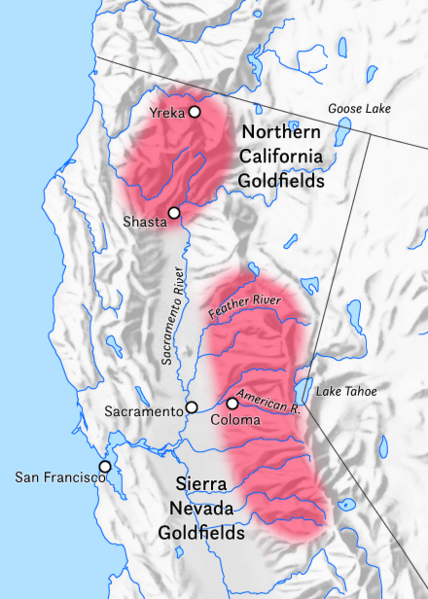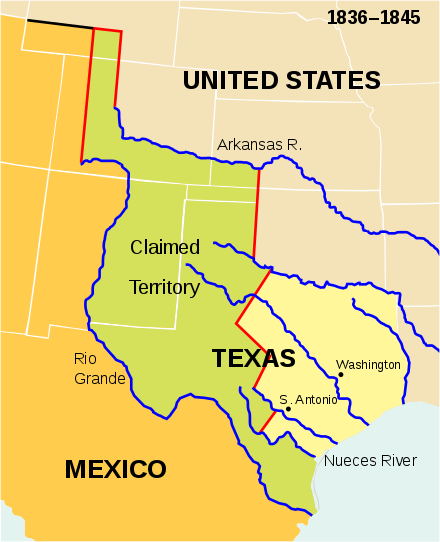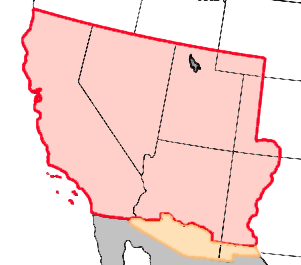
| ICE Case Studies
|
|
I.
Case Background |

The discovery of gold at Sutter's Mill in California in 1848 led to a huge influx of migration. These people came in search of quick riches, and some did become rich. Most did not. In a two-year span, more than 300,000 people. mostly men, came to California. (One estimate put the migrants as 80% male.) At first they mined only surface gold found along rivers. Later, they used high pressure hydraulic equipment to ferret out the elusive mineral. This tactic of course led to widespread destruction of riverine environments and caused massive erosion. For many people, the California Gold Rush was an environmental and livelihood disaster.
In 1846, American settlers in California, around Sonoma, revolted against Mexican rule. In the aftermath, they created the "Bear Flag Republic". The revolt was however quickly subsumed under the umbrella of the US Mexican War that began in 1846 and lasted until 1848. At the conclusion of the war, California was "purchased" by the United States as part of the peace treaty.
Spanish rule in California clung mostly along the coast and through the Central Valley. There was far less of a presence inland and east of the Sierra Nevada mountains. The Americans coveted California. Spain's rule was eroding and the British and the French had designs on it. Even the Russians, to the north, had a foothold in Alaska. This was classic geo-politics in the 19th century.
In the same year, gold was discovered in the state. It is a mystery why this remained hidden for so long. The gold that was found was not mined and lay in quantities in many streams and rivers that flow from the mountains. Spain had conquered the Aztecs and the Incans in order to acquire gold (and silver), so they were well aware of what it looked like. But they did not notice any gold in California for over 200 years.
Legend has it that one man found gold there. Johan Sutter was a German immigrant to owned a mill and other property in Northern California. He came to California in 1839. The population then counted a Native American population in the hundreds of thousands and a European population of around 1,000.
The United States was quickly successful in invading and conquering Mexico in the short-lived war. The war in California was largely blooodless. Statehood occurred remarkably fast. The United States acted rapidly to annex the state and bring it into the republic. In a remarkably short period, California became a state of the union in 1850. It was admitted as a free state.
During this turbulent period, there was conflict with Native Americans, Mexicans, and Californio's: the latter the mixed population that ran the local affairs. Many more Native Americans would die in the aftermath of the US-Mexico war and the subsequent take-over of California.
The Gold Rush Area

Up to this point however the conflicts had travelled along distinctly separate tracts, but two events brought them into collision. First, the United States defeated Mexico in a war and was awarded huge tracts of land in the southwest part of North America. This vast area included the new state of California. This meant the creation of new political structure and power centers in the state.
Second, the Gold Rush brought in an enormous amount of migrants in a brief period that changed the state demographics. It also brought in great wealth (for some), and hastened the socio-political transformation of the state. Native peoples too saw threats to their livelihoods form these new migrants. This was partly due to the ranching practices that was never part of their tradition and required so much land.
In 1836, after the Texas army commanded by Sam Houston defeated the army of Santa Ana and an independent republic was announced. It was immediately recognized by the United States, France, and Britain. All three also had great interest further west and to California. Despite opposition from the Whig Party, Texas was admitted in the United States in 1845.
The peak conflict period was 1848-50, but strife remained for many years afterwards, There was also conflict leading up to the war.
The area off the Owens River Valley is in the Eastern Sierra Nevada mountains. The Gold Rush took place in the mountain ranges rivers and tributaries on both sides of the mountain range.

This pollution is due to the introduction of high-volume hydraulic mining that emerged over time as a preferred "mining" method. The tactic obliterated riverine ecosystems where it was used. This fouled water quality and released huge amounts of minerals into the waters as well as sand which greatly increased turbidity. This in turn, killed of fresh water fish and ruined the water for drinking.
While the conflict in the United States included many temperate areas, they also included many dry ones as well. In Mexico, there tropical areas.

The state's native population plummeted from about 150,000 in 1848 to 30,000 just 12 years later.
Chinese gold seekers arrived in great numbers after 1851, and soon comprised about a fifth of the entire population in mining areas.
The California War and subsequent small scale conflicts lasted over a number of years. Far more Native Americans than Mexicans died in the wars over this time, mostly through indirect warfare. Mexico invited U.S. settlers into Texas in the hope of building a buffer zone between them and Native Americans, who continued raiding Mexican places. This worked well until the Americans revolted in 1836 from Mexico. The result was the Battle of the Alamo where Mexico defeated U.S. forces and killed all the defenders. Many U.S. citizens reacted and came to Texas to support the American citizens. They were successful in defeating the Mexican Army shortly thereafter in 1836. In 1845, Texas applied to the U.S. for annexation. This raised tensions along the Rio Grande border.
Approximate Texas Territory

https://en.wikipedia.org/wiki/Mexican%E2%80%93American_War, Creative Commons Graphic
U.S. President James Polk in 1845 offered Mexico compensation for claim to disputed land along the Texas border and ordered troops into the area when it was rebuffed. Mexico counter-attacked and these skirmishes led Polk to ask the U.S. Congress for a declaration of war. U.S. forces invaded Mexico and won the war in two years.
Territory Mexico Ceded to the United States

Source: https://en.wikipedia.org/wiki/Mexican%E2%80%93American_War, Creative Commons Graphic
The 10,000 casualties are only for the U.S.-Mexico War and do not include the Texas Rebellion of the later conflcit with
Native Americans in California and elsewhere in the aftermath of the war.

One other factor though was that Mexico has been independent from Spain for only 20 years or so, so there was not a strong central government. In fact, Spain still maintained control of some areas and claimed sovereignty over Mexico for years afterwards.

Diamonds and Liberia's Civil War
Silver and the Spanish Conquering of the Aztecs
Diamonds and Angola's Civil War
Congo, Coltan, and Civil Violence
Go to Ice Search Engine and Scenario Builder
Engelson, Lester G. (1939). "Proposals for the Colonization of California by England: In Connection with the Mexican Debt to British Bondholders 1837-1846". California Historical Society Quarterly. University of California Press. 18 (2): 136–48. ISSN 0008-1175. JSTOR 25139106. doi:10.2307/25139106 – via JSTOR.
K. Jack Bauer, The Mexican war, 1846–1848. 1974. Republished by University of Nebraska Press 1992.
Walker, Dale L. (1999). Bear Flag Rising: The Conquest of California, 1846. New York: Macmillan. p. 104. ISBN 0312866852.
"Essay: 1848-1865: Gold Rush, Statehood, and the Western Movement", University of California, "1848-1865: Gold Rush, Statehood, and the Western Movement" was written by Joshua Paddison and the University of California in 2005 as part of the California Cultures project. Source: https://calisphere.org/exhibitions/essay/4/gold-rush/
